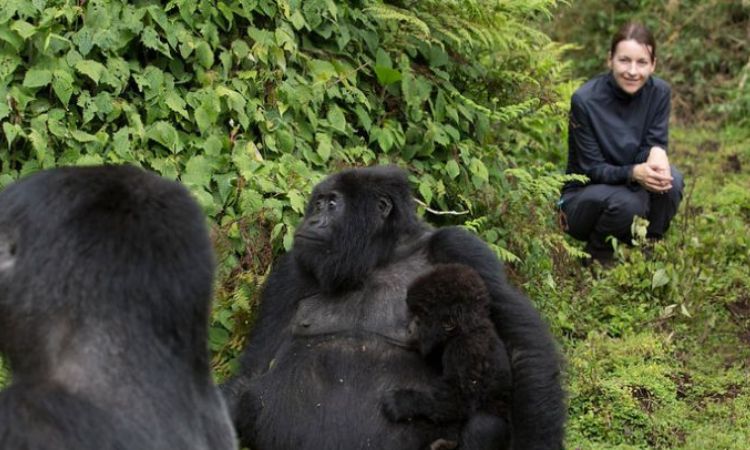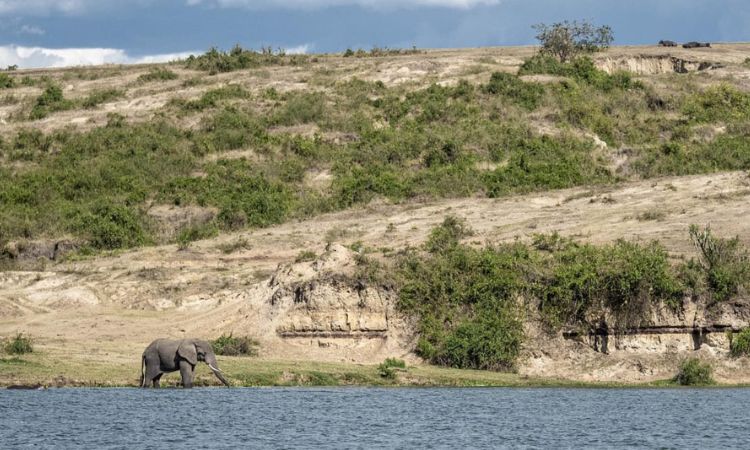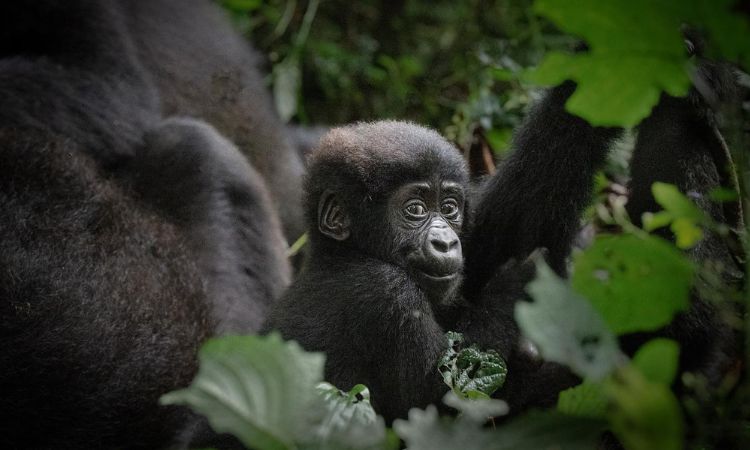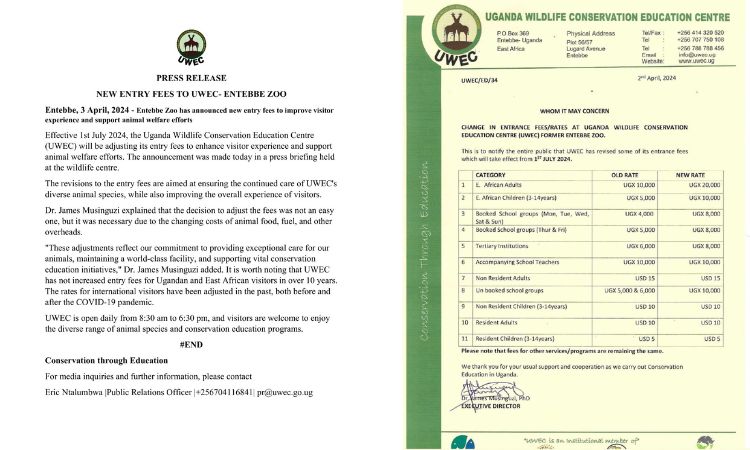Why Do Gorillas Turn Their Backs to Humans: Top 3 Facts
Why Do Gorillas Turn Their Backs to Humans: Discover why gorillas often turn their backs to humans, what this behavior means, and how it reflects their peaceful nature and social communication.
Introduction
When trekking through the dense forests of Uganda, Rwanda, or the Democratic Republic of Congo, many tourists notice something intriguing: gorillas, especially dominant silverbacks, often turn their backs to humans. This behavior sparks curiosity—why do gorillas turn their backs to humans?
Far from being a sign of rudeness or fear, this gesture is a fascinating glimpse into the world of gorilla communication and body language. Gorillas, known for their intelligence and gentle nature, use subtle postures to convey trust, calmness, and social hierarchy.
In this comprehensive guide, we’ll explore the reasons behind this behavior, what it means in the context of gorilla trekking, and how it reflects the emotional intelligence of these remarkable primates.
Understanding Gorilla Body Language
Gorillas are highly social animals that rely on non-verbal cues to communicate within their groups and with outsiders, including humans.
Their body language includes postures, gestures, facial expressions, and vocalizations, each carrying specific meanings.
Turning their back is one such gesture, deeply rooted in gorilla communication and body language. This behavior is not random; it’s a deliberate signal that conveys their emotional state or social intent.
For example, a gorilla may turn away to show it is comfortable or to assert dominance without direct confrontation. This is especially common in gorilla behavior toward humans during trekking encounters, where gorillas are habituated to human presence but still maintain their natural instincts.
Understanding these cues helps us interpret how gorillas show dominance and submission, ensuring safe and respectful interactions.
The Real Meaning of Turning Their Backs
So, why do gorillas turn away from people? This behavior typically signals one of three things:
- A Sign of Trust: When a gorilla turns its back, it often indicates that it doesn’t perceive you as a threat. In the wild, exposing their back is a vulnerable position, so this gesture suggests they feel secure in your presence.
- A Gesture of Calmness: Turning away is a peaceful act in silverback gorilla behavior. It shows the gorilla is relaxed and not interested in escalating any interaction into conflict.
- Avoiding Confrontation: For dominant silverbacks, turning their back can be a way to assert control while de-escalating tension. By not engaging directly, they maintain their authority without needing to display aggression.
These peaceful gorilla gestures highlight their preference for harmony over confrontation, making them one of the most misunderstood yet gentle giants of the animal kingdom.
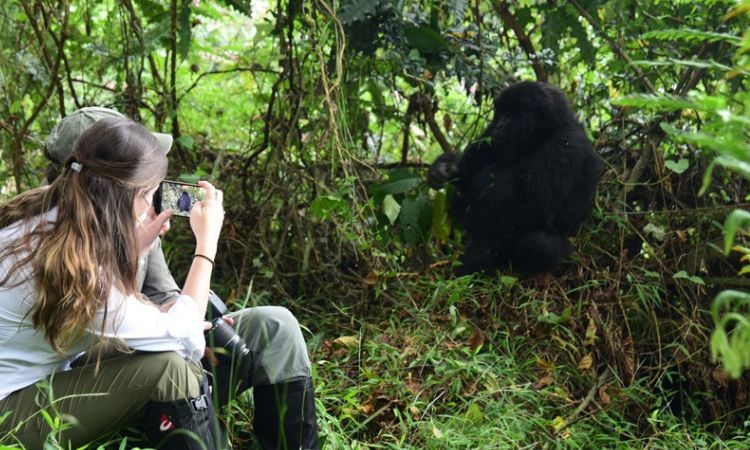
Silverback Gorilla Behavior and Protection
The silverback, the dominant male leader of a gorilla group, plays a crucial role in protecting his family. When a silverback turns his back to humans, it’s often a calculated move.
This silverback gorilla turning back meaning can indicate that he is monitoring potential threats while keeping his group safe. By positioning himself between humans and his family, he creates a barrier, signaling both control and calmness.
This behavior is also a hallmark of silverback gorilla dominance behavior. Silverbacks are responsible for the safety of their group, and turning away can be a strategic way to observe humans indirectly while maintaining a non-threatening posture.
During gorilla trekking, this gesture often reassures guides that the silverback is comfortable, allowing tourists to observe the group safely.
Understanding how silverbacks protect their family deepens our appreciation for their complex social dynamics.
Gorillas and Human Interaction During Trekking
Gorilla trekking in destinations like Bwindi Impenetrable Forest in Uganda or Volcanoes National Park in Rwanda offers a rare chance to observe mountain gorillas in Uganda and Rwanda.
During these encounters, park rangers enforce strict rules, such as maintaining a 7–10 meter distance, to ensure the safety of both gorillas and humans.
When gorillas turn their backs, it’s often a sign they are comfortable with the group’s presence, reflecting successful habituation efforts.
This gorilla trekking behavior shows how gorillas react to humans in a controlled, respectful setting. Habituated gorillas are accustomed to human observers but remain wild animals with natural instincts.
When they turn away, it’s a positive indicator that they don’t feel threatened, allowing trekkers to witness their daily activities, from grooming to foraging, without disruption.
Common Misinterpretations
It’s easy to misinterpret a gorilla turning its back as a sign of rudeness, fear, or disinterest, but this couldn’t be further from the truth. This behavior is a natural part of gorilla signs of aggression (or lack thereof) and social interaction.
Turning away is not a prelude to aggression but rather a way to maintain peace. However, sudden movements, loud noises, or prolonged direct eye contact can make gorillas uncomfortable, potentially altering their calm demeanor.
Understanding gorilla emotions is key to avoiding missteps during trekking. For instance, staring directly into a gorilla’s eyes can be perceived as a challenge, while slow, deliberate movements signal respect. By recognizing these cues, humans can foster positive interactions and avoid triggering defensive responses.
Connection Between Humans and Gorillas
Gorillas share approximately 98% of their DNA with humans, a fact that underscores their emotional and social complexity. This close genetic link contributes to their emotional intelligence in gorillas, evident in their nuanced communication and group dynamics.
Behaviors like turning their backs reveal a shared capacity for trust and non-verbal understanding, bridging the gap between human and gorilla similarities.
Conservation efforts, such as those supported by the Dian Fossey Gorilla Fund and WWF, have made gorilla trekking possible while protecting these endangered primates.
Responsible tourism not only funds gorilla conservation and tourism but also fosters a deeper appreciation for these animals, encouraging global efforts to preserve their habitats.

FAQ: Common Questions About Gorilla Behavior
Why do gorillas turn their backs during encounters?
Gorillas turn their backs to show trust, calmness, or to avoid confrontation, signaling they don’t perceive humans as a threat.
Is it safe when a gorilla turns its back on you?
Yes, it’s generally a sign of comfort, especially during guided treks with trained rangers maintaining safe distances.
Do silverback gorillas ignore humans?
Silverbacks don’t ignore humans but may turn away to assert control or focus on protecting their group.
What should you do when a gorilla turns away?
Stay calm, maintain the recommended distance, avoid direct eye contact, and follow your guide’s instructions.
Conclusion
Gorillas turning their backs to humans is a powerful yet subtle gesture that speaks volumes about their peaceful nature. Far from being a sign of aggression or disinterest, it reflects trust, calmness, and a desire to maintain harmony.
This behavior, observed during gorilla trekking in Uganda, Rwanda, and Congo, offers a window into the emotional intelligence of these remarkable primates.
By understanding why do gorillas turn their backs to humans, we gain a deeper appreciation for their social complexity and the importance of conservation efforts that allow us to witness these moments in the wild.
Respectful interactions not only enrich our experiences but also support the preservation of mountain gorillas for future generations.
